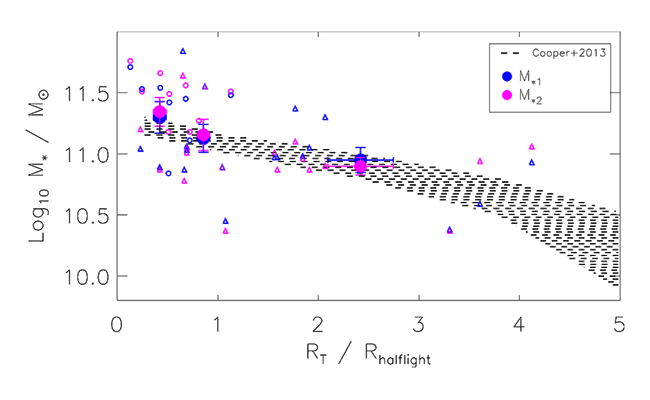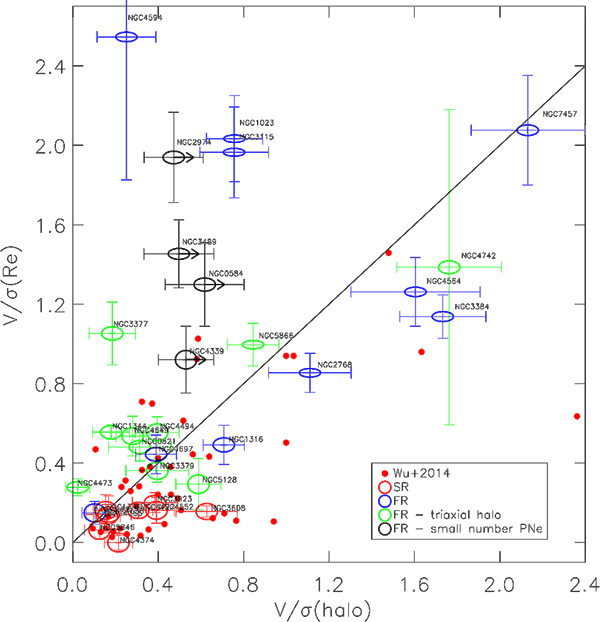ING web news release
7 December, 2018
The Extended Planetary Nebula Spectrograph (ePN.S) Early-type Galaxy Survey
Cosmological simulations predict that early-type galaxies (ETGs) are the results of extended mass accretion histories characterised by different numbers of mergers and merger mass ratios, their timing, and gas fractions. Depending on the sequence and nature of the mergers following the first phase of in-situ star formation, these accretion histories may lead to ETGs that have low or high mass halos, and that rotate fast or slow.
In order to study the transition from the inner regions of ETGs to their outer accretion dominated halos, Pulsoni, Gerhard, Arnaboldi and the PN.S team carried out a survey of 33 ETGs, the ePN.S sample, using planetary nebulae as tracers. The use of these single stars that are particularly bright in the Oxygen green light allows the limitation of absorption line spectroscopy at low surface brightness to be overcome in the halos of these galaxies.
Using data obtained with the custom-built Planetary Nebulae Spectrograph (PN.S) mounted on the William Herschel Telescope (WHT), Pulsoni and the PN.S team measured the two dimensional line of sight velocity and velocity dispersion maps for 33 ETGs within 20 Mpc distance. This sample includes both fast (FRs) and slow (SRs) rotators.
These velocity fields were reconstructed from the measured single PN velocities using an adaptive kernel procedure that has been validated with simulations. The advantage of using planetary nebulae as motion tracers allowed the PN.S team to extend the velocity fields of the stars out to about 6 effective radii (Re), on average. Absorption line kinematic data were then added in the central high surface brightness regions to facilitate the complete mapping of the stellar motions from the centre to the periphery of the halos.
For the first time, Pulsoni and the PN.S team demonstrated that ETGs display a "kinematic transition radius" between their inner regions and halos. The estimated transition radii for this sample of ETGs, in units of Re, anticorrelate with the stellar mass in these galaxies. In other words, in more massive galaxies the halo's kinematical properties apply to a larger fraction of the stellar mass than in less massive galaxies.
In Figure 1, the observed anticorrelation of the transition radius RT is compared with predictions from cosmological simulations showing a substantial agreement.
|

|
Figure 1. Transition radius in units of the radius containing half the light vs. total stellar mass (open symbols: circles for SRs, triangles for FRs). The full circles show these quantities in bins of RT/Rhalflight. Different colours show the results of two different procedures for calculating the total stellar mass. The observed anticorrelation of the transition radius R T, compared with predictions from cosmological simulations, showing a substantial agreement.
Credit: Magda Arnaboldi. Large format: [ PNG]. |
The investigation of the kinematic properties of the stellar halos in the sampled ETGs showed a very interesting diversity of kinematical properties with respect to the inner regions. While the SRs have increased - though modest - rotational support at large radii, most FRs show a decrease in rotation. This behaviour is consistent with the fading of the inner disk in the outer, more slowly rotating spheroid. The distribution of the angular momentum properties of this ETGs sample is shown in Figure 2, with only about 30% of the FRs displaying similar amount of rotation in the inner region and in the halo.
Pulsoni and the PN.S team further investigated the behaviour of the velocity dispersion profiles in this sample. While most ETGs have a flat or a slightly falling velocity dispersion profile in the outer halo, about 15% of the galaxies in the ePN.S sample have steeply falling profiles. This latter class of system is not predicted by the current merger simulations for the formation of ETGs.
Another interesting result from the ePN.S ETG sample is the evidence for kinematics twists and misalignments of the kinematic and photometric axes in the halos. All SRs and 40% of the FRs in the ePN.S sample show signatures of triaxial halos. Using toy models, Pulsoni et al. show that this fraction is consistent with the distribution of isophote twists from extended photometry.
|

|
Figure 2. V/σ(R e) from absorption line data compared with V/σ(halo) from PN data. The flattening of the ellipses used to plot the galaxies corresponds to the ellipticity value ε of the isophotes. While slow rotators (SRs) show increased rotation in their halos, the majority of fast rotators (FRs) show a decrease in rotation at large radii. FRs and SRs are shown with different colours, as are the FRs with triaxial halos. The solid line traces equal values at Re and in the halo for the rotation. The orange dots show corresponding V/σ values of simulated galaxies from Wu et al. 2014, MNRAS, 438, 2701 which did not predict as large rotation in the halos as measured. Credit: Magda Arnaboldi. Large format: [ PNG].
|
In conclusion, this study shows that ETGs have more diverse kinematic properties in their halos than in the central regions. FRs do contain inner disk components but these frequently fade in outer spheroids, which are often triaxial. The observed kinematic transition to the halo and its dependence on stellar mass is consistent with ΛCDM simulations, supporting the importance of the extended accretion history in the formation of ETGs.
We are grateful to Nigel C. Douglas for his fundamental contribution to the construction of the Planetary Nebula Spectrograph.
More information:
C. Pulsoni, O. Gerhard, M. Arnaboldi, L. Coccato, A. Longobardi, N.R. Napolitano, E. Moylan, C. Narayan, V. Gupta, A. Burkert, M. Capaccioli, A. L. Chies-Santos, A. Cortesi, K.C. Freeman, K. Kuijken, M. R. Merrifield, A.J. Romanowsky, C. Tortora, 2018, "The extended Planetary Nebula Spectrograph (ePN.S) early-type galaxy survey: The kinematic diversity of stellar halos and the relation between halo transition scale and stellar mass", A&A, 618, 94 [ ADS ].

The Planetary Nebula Spectrograph (PN.S) is a custom-built instrument mounted at the WHT. This instrument is a double-arm slitless spectrograph that facilitates the identification of PNe and measures their line-of-sight velocities in a single observation.More information on http://www2011.mpe.mpg.de/opinas/research/DynamicsGroup/pns/.
|
|



